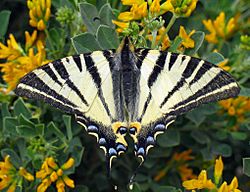Iphiclides facts for kids
Quick facts for kids Iphiclides |
|
|---|---|
 |
|
| Scarce swallowtail (Iphiclides podalirius) | |
| Scientific classification | |
| Kingdom: | |
| Phylum: | |
| Class: | |
| Order: | |
| Family: | |
| Subfamily: | |
| Tribe: |
Leptocircini
|
| Genus: |
Iphiclides
(Hübner, 1807)
|
| Species | |
|
See text. |
|
Iphiclides is a genus (a group of closely related living things) of beautiful butterflies. These butterflies belong to the family called Papilionidae, which is known for its large, often colorful butterflies with tail-like extensions on their hindwings.
Contents
What is the Iphiclides Genus?
The Iphiclides genus was first described by Jacob Hübner in 1807. Butterflies in this group are found in parts of Europe, Asia, and North Africa. They are known for their striking patterns and graceful flight.
Species of Iphiclides
There are a few main species that are part of the Iphiclides genus. Each species has its own unique features, but they all share common traits that place them in this group.
- Iphiclides feisthamelii (Duponchel, 1832) - This butterfly is often called the Southern Swallowtail. It looks very similar to the Scarce Swallowtail but lives in different areas, mainly in the Iberian Peninsula (Spain and Portugal) and parts of North Africa.
- Iphiclides podalirius (Scopoli, 1763) - This is the Scarce Swallowtail, one of the most famous butterflies in this genus. It has pale yellow wings with black stripes, making it look a bit like a zebra. It also has blue and red spots near its "tails." You can find it across much of Europe and Asia.
- Iphiclides podalirinus (Oberthür, 1890) - This species is found in parts of Asia. It is closely related to the Scarce Swallowtail but is considered a separate species.
Where Iphiclides Butterflies Live
These butterflies prefer warm, open areas. You can often spot them in meadows, orchards, and gardens. They especially like places where their favorite food plants grow. The caterpillars of Iphiclides butterflies usually feed on plants from the rose family, like blackthorn, hawthorn, and fruit trees such as plum and cherry.
Life Cycle of Iphiclides Butterflies
Like all butterflies, Iphiclides species go through a complete metamorphosis.
Eggs and Larvae
The female butterfly lays tiny eggs on the leaves of host plants. Once the eggs hatch, small caterpillars (larvae) emerge. These caterpillars spend their time eating and growing, shedding their skin several times as they get bigger.
Pupae and Adults
After reaching full size, the caterpillar forms a pupa (chrysalis). Inside the pupa, the amazing transformation into a butterfly happens. Finally, the adult butterfly emerges, ready to fly, find a mate, and lay eggs to start the cycle all over again.
See also
 In Spanish: Iphiclides para niños
In Spanish: Iphiclides para niños

